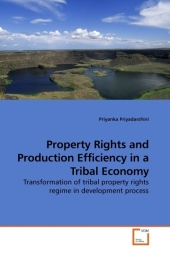 Neuerscheinungen 2010Stand: 2020-01-07 |
Schnellsuche
ISBN/Stichwort/Autor
|
Herderstraße 10
10625 Berlin
Tel.: 030 315 714 16
Fax 030 315 714 14
info@buchspektrum.de |

Priyanka Priyadarshini
Property Rights and Production Efficiency in a Tribal Economy
Transformation of tribal property rights regime in development process
2010. 124 S.
Verlag/Jahr: VDM VERLAG DR. MÜLLER 2010
ISBN: 3-639-22098-6 (3639220986)
Neue ISBN: 978-3-639-22098-8 (9783639220988)
Preis und Lieferzeit: Bitte klicken
The empirical study examines the nature and extent of property rights institutions emerging in the process of diversification of tribal economy of Arunachal Pradesh as a result of state-led development interventions. What is evident in the study is that the institutions emerge as a consequent of development interventions to meet the institutional requirements of such interventions subsequently. The study finds that the relationship between property rights and production efficiency has not been uniform in three sectors of the economy with a discernible positive relationship in agricultural sector and erratic trend in both secondary and tertiary sectors. Further, some features have emerged which did not exist earlier; with the establishment of property rights in land inequalities in the ownership of land, income and capital have emerged. So the inference, though implicit, points to the logic that positive and desirable relationship between property rights and production efficiency depends on enabling environment - the existence of both necessary and essential prerequisites.
Priyanka Pryiadarshin, Ph.D, Asst. Professor in Economics at J.N. College, Pasighat, Arunachal Pradesh, has been working for a period of about one decade on development interventions and dynamics of tribal and institutional economics.


